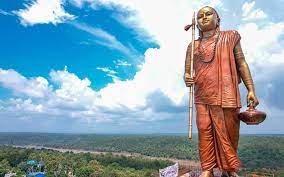Adi Shankaracharya : Statue

The Madhya Pradesh Chief Minister recently unveiled a 108-feet statue of Adi Shankaracharya, an 8th-century Vedic scholar and teacher, in Omkareshwar.
- Adi Shankaracharya was an ancient Indian philosopher and theologian who lived in the early 8th century CE.
- He was born in Kalady, a village in present-day Kerala.
- He is best known for his role in the development and propagation of Advaita Vedanta, a non-dualistic school of Hindu philosophy.
- He amalgamated the ideologies of ‘Advaita Vedanta’ and also explained the basic ideas of Upanishads.
- His most important work is his efforts to synthesize the six sub-sects, known as ‘Shanmata.’ ‘Shanmata’, which literally translates to ‘six religions,’ is the worship of six supreme deities.
- Shankaracharya explained the existence of one Supreme Being (Brahman) and that the six supreme deities are part of one divine power.
- He established four prominent monastic centers in India, each associated with one of the cardinal directions: Sringeri in the south, Dwarka in the west, Puri in the east, and Badrinath in the north.
- He wrote 18 commentaries on major religious scriptures like the Bhagavad Gita, Brahmasutras, and 12 major Upanishads.
- His review of ‘Brahma Sutra’ is known as ‘Brahmasutrabhasya’, and it is the oldest surviving commentary on ‘Brahma Sutra’.
- He wrote 23 books on the principles contained in the Advaita Vedanta philosophy, including Viveka Chudamani, AtmaBodha, Vakya Vritti, Upadesa Sahasri, etc.
- 72 devotional hymns and meditational hymns like Soundarya Lahari, Nirvana Shatakam, Maneesha Panchakam.
- Adi Shankaracharya is believed to have attained Samadhi (a state of deep meditation or realization) at the young age of 32 in Kedarnath in the Himalayas.




